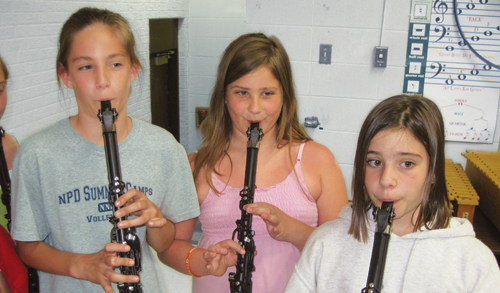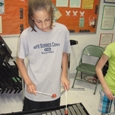
Throughout 13 years of experience as an elementary and middle school band director, I have never had a percussion section exhibit the same notereading speed and accuracy as the wind players in my band. There are usually a few individuals who take private piano or percussion lessons and read very well, but the great majority struggle with notereading compared to the wind players.
I had an excellent seventh grade clarinet player whose instrument was in the shop, so I asked her to join the percussion section for a day. She had no piano experience, and had to be shown where middle C was on the marimba. Within ten minutes, she was reading and playing better than most of the others in the section. They were aghast that a non-percussionist could sightread a piece that took them hours to learn.
In another example, a seventh grade percussionist found her mother’s old clarinet in the attic. She decided to come after school for extra lessons so she could learn to play it. Within two weeks she worked through more than half of the method book. It was at this time that I asked her to sightread a new piece on xylophone. She looked at it briefly and then gleefully exclaimed, “I know these notes. I played them on the clarinet.” The funny thing was that she knew those notes all along. As a percussionist she had been taught those notes in fourth, fifth, and sixth grade, with three different teachers. Something had changed in how she looked at notereading. This experience made me think about how I teach notereading to percussionists.
The major music pedagogical models propose that tactile learning is essential for understanding pitch and literacy, particularly Orff, Dalcroze, and Suzuki. I thought it might be helpful to give percussionists a different type of tactile experience to see if their notereading skills would improve.
Consider how percussionists traditionally learn pitches on bells. When struck with a mallet, Bb feels the same as a C. Out of context, a student has no way to know if it is even the right note. Further-more, a bell player always has two visual targets at any given time: the music page and the key or bar on the instrument. Beginning bell players rarely learn how to follow the notes on the page properly because they keep switching their eyes from the written pitches to the bell set.
A clarinet player can feel the difference between Bb and C. The difference in touch is reinforced by the difference in sound. Clarinet students also learn to track more easily because they are not shifting their focus from the page to the instrument.
To test whether teaching percussionists a six-week unit of tactile-based music reading would improve their reading speed and accuracy, I adapted my teaching methods with fourth grade (first year of instruction), fifth grade (second year) and the seventh grade students (fourth year).
Study Design
With funding from my district’s foundation, I purchased 30 clarineo instruments. A clarineo is an inexpensive clarinet pitched in the key of C. Because it is a non-transposing instrument, percussionists can play it in lieu of a mallet instrument. It is constructed almost entirely out of plastic, and the holes and keys are spaced together to make it easier for smaller children to play. There are no redundant or duplicate keys like a clarinet has, but it can play a chromatic scale.
I chose the clarineo over the recorder because all of my students had previous recorder experience in school, and the recorder fingerings are not as intuitive as the clarineo. Once a student moves beyond the basic six notes, the recorder loses its predictable fingering patterns. An unexpected benefit occurred when the percussionists found that they were using the same fingerings as the clarinet players. It sparked a lot of musical discussion between the two groups that would not have occurred otherwise, such as when it is appropriate to use a Bb fingering instead of a B natural fingering. I also chose the clarineo because in a study where the feel of a note was crucial, I wanted an instrument with more substance than the simple hole of the recorder. The rings around the upper fingers, the pinky keys, the A key, Ab key, and register key added an important element.
Prior to the clarineo instruction, I gave students a survey and asked them to indicate how comfortable they were playing three progressively harder excerpts using a range of notes that were common for a mallet player. I also asked students to disclose whether or not they had significant piano experience (two years or more). For the purposes of this study, I excluded those students, since they had a clear advantage.
Students then progressed sequentially through the method book that was included with the instrument. As a group we played through at least three or four lines each week. I then directed students to advance as far as possible for the next lesson. In addition to the method book, I also taught the seventh graders how to play our full band warmup on the instrument, which includes a chromatic scale. The lesson groups remained fairly evenly paced, with a few advanced students given permission to work ahead when ready.
Following the six-week unit, students completed a second survey. I measured the differences in perception about their experience and also made my own evaluations of the changes in their playing abilities.
Results
The results of this study were surprising. Most seventh graders completed the book (9 out of 10), but only a few fourth and fifth graders were able to finish it (4 out of 14). The seventh graders were nearly unanimous in their findings. All players except one found that the unit improved their confidence, notereading speed, and notereading accuracy. In fact, 6 out of 10 players wanted to keep the instruments. Several talked about forming a small ensemble for the district solo/ensemble festival. I believe that much of the the excitement about the instrument came from the improvements that they saw each week.
The seventh graders worked exclusively on the clarineo in lessons while they rotated between clarineo/mallet parts and non-mallet parts in full band rehearsals. As a result these students had many opportunities to connect the notereading advancements on the clarineo to notereading on the mallet instruments. The combination of the lessons and band allowed them to progress at a fast rate – enough that at times they could see steady improvement from one day to the next. The seventh grade students all felt they read notes more quickly and accurately after the unit. Their subsequent mallet playing throughout the school year demonstrated improved playing ability.
The fifth grade class saw similar increases in their perceived ability to play and read music, but not as much as the seventh graders. The fifth graders immediately saw the value of playing the wind instrument. However, with less experience on the mallet instruments, many found it difficult to connect the two dissimilar instruments. They were excited about the project but did not see the same marked growth. Only three fifth grade students finished the method book. The survey after the unit revealed slight gains in perceptions about their ability to read faster and more accurately. The smaller gains may be partly because they had less instruction time each week than the seventh grade students.
The fourth grade beginner class made the least progress with this project, largely because they signed up for band to play percussion, not clarinet. Without any prior experience, nearly all of these students struggled to progress past the first three notes. They were slightly skeptical of the study, even after I explained how it would help their notereading. They also had the most difficulty producing an initial tone on the instrument, which came easily to the seventh graders.
When they transferred to bell sets, we had to start over in the band method book. I saw little evidence that the fourth graders carried concepts from clarineo to the bells. Contributing to the lack of progress by the fourth graders was limited lesson time; these students met only once a week for a percussion lesson. Unlike the fifth and seventh graders, they had no mallet experience to provide a context for note-learning and did not have a weekly full ensemble rehearsal to practice the notereading they had begun in lessons. (Beginners do not join full band until their tenth week). They also did not feel that they had improved as much as students in other grade levels.
Conclusions
I will definitely continue clarineo instruction as an annual notereading unit with seventh grade students. It is also a useful tool to assist experienced percussionists who are uncomfortable with reading and performing mallet parts. Whether it is used with an entire group or an individual student, learning to play a simple woodwind instrument improves percussion students’ notereading skills. I will also continue using the method with my fifth grade students. After a year of instruction, they have learned enough about playing a mallet instrument and notereading to apply the skills they develop on the clarineo back to their percussion playing.
Beginning percussionists are anxious to play percussion and only percussion. They do not have the same motivation and knowledge as more experienced percussionists to fix a problem that they do not yet know exists.
It is unclear whether the positive results found in the seventh graders are a result of age and cognitive development or just greater playing experience. It would be interesting to see how a beginning seventh grade student would do. It is also possible that more lesson time would produce better results in younger students. I do not intend to use this method again with my beginners, but will continue to teach this instrument to older students to advance their notereading speed and accuracy on mallets.






